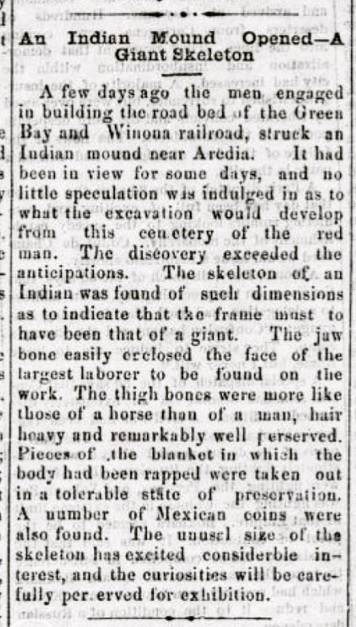Trempealeau County – THAT OF A GIANT
 THIGH BONES MORE LIKE THAT OF A HORSE
THIGH BONES MORE LIKE THAT OF A HORSE
A few days ago the men engaged in building the road bed of the Green Bay and Winona railroad, struck an Indian mound near Arcadia. It had been in some view for some days, and no speculation was indulged in as to what the excavation would develop from this from this cemetery of the red man. The discovery exceeded the expectations. The skeleton of an Indian was found of such dimensions as to indicate the frame must have been that of a giant. The jaw bone easily enclosed the fac
“An Indian Mound Opened – A Giant Skeleton
A few days ago, the men engaged in building the roadbed of the Green Bay and Winona railroad, struck an Indian mound near Aredia. It had been in view for some days, and no little speculation was indulged in as to what the excavation would develop from this ancient burial site.
The discovery exceeded their expectations. The skeleton of an Indian was found of such dimensions as to indicate that the frame must have been that of a giant. The jawbone easily enclosed the face of the largest laborer to be found on the work. The thigh bones were more like those of a horse than of a man, with heavy hair that was remarkably well preserved. Pieces of the blanket in which the body had been wrapped were taken out in a tolerable state of preservation. A number of Mexican coins were also found.
The unusual size of the skeleton has excited considerable interest, and the curiosities will be carefully preserved for exhibition.”
The discovery of a giant skeleton is an incredibly rare and significant find in the world of archaeology and anthropology today. The fact that the frame was so large as to indicate a giant stature is remarkable, as this is an extremely unusual occurrence in modern times. If this skeleton had not been lost to time or found in a museum storage somewhere, it could have provided invaluable insights into the physiology and lifestyle of these early indigenous peoples.
The jaw bone alone could easily enclose the face of the largest laborer on the work, indicating a massive skull size. The thigh bones were more like those of a horse than a human, which would have allowed for immense strength and potentially an impressive range of motion. The blanket in which the body was wrapped was also well-preserved, which could have provided valuable information about the materials and techniques used by these early people.
It’s essential to remember that early indigenous peoples were often viewed as “primitive” or “uncivilized” by colonizers and scholars of the time. The discovery of this giant skeleton could have shattered those misconceptions and provided a more accurate understanding of their capabilities, customs, and beliefs. It is a shame that the skeleton was not preserved and put on display, as it would have been a fascinating and enlightening artifact for future generations.
- The Lagrange Advance, October 15, 1873
- Wisconsin, Trempeleau County, Dodgeville Chronicle, 1873